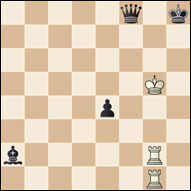We looked last month at how a pair of bishops can control an enemy king - they can 'shepherd' it. A pair of rooks can do that too, and indeed the rook pair can do more - they can force a king across the board and then mate it.
White to play and win
This is by P Babich and was an entry in the Ural CPS event in 1950.
The first moves are easy to find, because Black is going to have lots of checks when he gets the move, so it has to be a rook to the a-file, and it has to be the c2-rook, as 1.Ra1+ K~ 2.Rb2+ lets the black king escape. Therefore 1.Ra2+ K~ 2.Rb2+ and we will mate unless Black plays 1...Kb5, so it's 1...Kb5 2.Rb2+ Nb3 3.Rxb3+ Ka4 and now what? We need to threaten a mate, and we could play 4.Rb7 or 4.Rb8. If we play 4.Rb7, however, Black will check on g2, take the rook and then when we play Ra1+ he will move his king towards the queen and protect it from the skewer. So the only option is 4.Rb8, when Black plays 4...Qg3+ 5.Kf7 Qxb8 6.Ra1+ Kb5 7.Rb1+ and White wins. Pleasant, but a bit light on content for a study composed in 1950 - so you should ask yourself if there's more to it. Which should lead you to the alternative fifth move 5...Qe5: then we get 6.Ra1+ Qxa1 7.Ra8+ and wins - a near perfect echo of the 5...Qxb8 line.
The full solution is 1.Ra2+ Kb5 2.Rb2+ Nb3 3.Rxb3+ Ka4 4.Rb8 Qg3+ 5.Kf7 Qxb8 6.Ra1+ Kb5 7.Rb1+ and 5...Qe5 6.Ra1+ Qxa1 7.Ra8+.
That idea of sacrificing one of the shepherding rooks is ancient. Here's a position from more than five centuries ago (!).
Black to play, White wins
Black plays 1...Kd6, threatening mate and the rook, met by 2.Rh5 Rxh5 3.Ra6+ K~ 4.Ra5+ winning. That is in the Civis Bononiae manuscript of 1454.
Here are two studies for you to solve. The first is by M Platov, from Shakhmaty in 1927.
White to play and win
The second is by A Grin (also known as A Gulaev), and is from the Drosha Tourney of 1966.
White to play and win … the solutions are shown below!
(Platov)
1. Ra4+ Kg5 2.Rc5+ Kf6 3.Ra6+ Ke7 4.Rc7+ Kd8 5.Rh7 Qxh7 6.Ra8+ K~ 7.Ra7+, or 5...Qg2 6.Ra8+ Qxa8 7.Rh8+ winning. The same echoes as in the Babich - Platov found the idea first.
(Grin)
1.Rh1+ Kg8 2.Kh4+ Kh7 3.Kg3+ Kg8 4.Kh2+ Kh7 5.Kg1+ wins. After 1.Rh1+, every move is a king move.
1.Rh2+? Kg8 2.Kh4+ Kh7 3.Kg3+ Kg8 4.Kh3+ Kh7 5.Kg2+ Qh6 6.Rgh1 Qxh2+. In the main line, 2.Kh5+? Qg7 3.Rhg1 Bf7+. Also in the main line, 4...Qg7 5.Rhg1.
The rooks aren't shepherding the king? Well, they kind of are - they don't move, but they achieve the same job.








